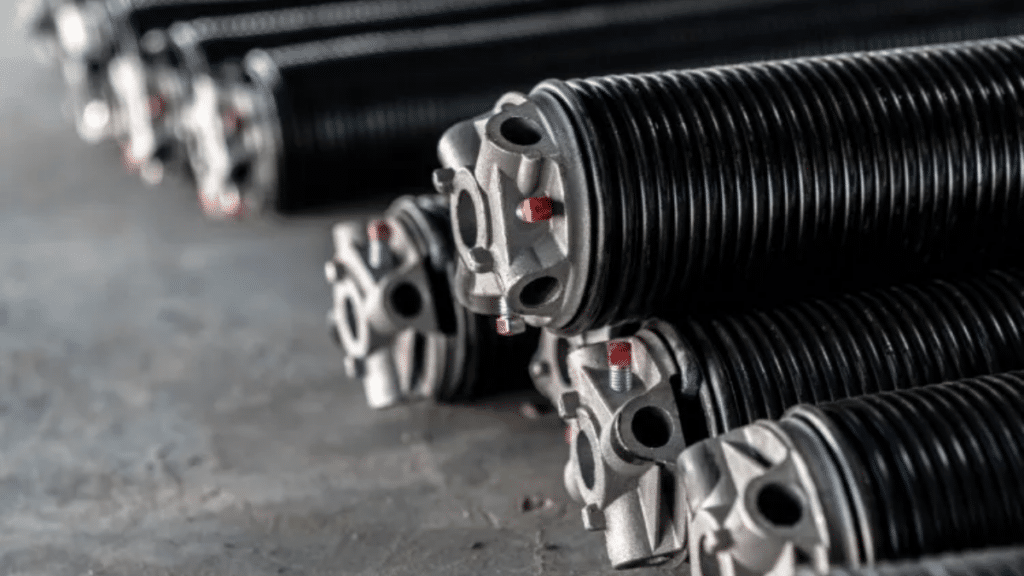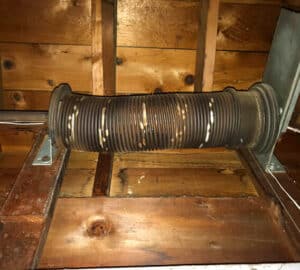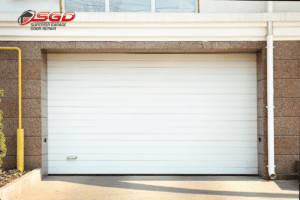Garage door springs are an essential part of your garage door mechanism. They are responsible for bearing the weight of the door as it opens and closes. However, when garage door springs malfunction, they can pose a grave threat to your safety and the security of your property.
It is crucial to understand the potential dangers associated with garage door springs to avoid any unfortunate accidents. In this section, we will discuss the hazards associated with broken garage door springs, the importance of timely maintenance, and the consequences of ignoring their repair or replacement needs.
Key Takeaways:
- Malfunctioning garage door springs can pose a severe threat to your safety and security.
- Timely maintenance and regular inspections can help prevent garage door mishaps and accidents.
- Ignoring repair or replacement needs can result in costly damages and hazardous consequences.
- Always seek professional assistance when dealing with garage door spring issues.
- Do not attempt DIY repairs as they can be dangerous and lead to further damage to the door or yourself.
Understanding Garage Door Springs
Garage door springs are the backbone of your garage door’s opening and closing mechanism and play a crucial role in its maintenance. There are two main types of garage door springs: torsion springs and extension springs.
Torsion springs are the most common type of garage door springs and are usually located on the top of the door. These springs work by winding and unwinding to lift and lower the door.
Extension springs, on the other hand, are installed on both sides of the door and extend as the door opens. These springs store energy to help lift the door and release it when closing.
Both torsion and extension springs require professional installation and should only be repaired by a professional if they are damaged. Attempting to fix them on your own can result in serious injury.
Torsion Spring for Garage Door
| Type | Diameter | Length |
|---|---|---|
| Oil tempered | 1 3/4″ | 32″ |
| Galvanized | 1 3/4″ | 32″ |
| Oil tempered | 2″ | 32″ |
| Galvanized | 2″ | 32″ |
Extension Spring for Garage Door
| Type | Size | Length |
|---|---|---|
| Open loop end | 7′ | 25′ |
| Open loop end | 8′ | 25′ |
| Double loop end | 7′ | 25′ |
| Double loop end | 8′ | 25′ |
If you’re not sure what type or size of garage door spring is right for your door, consult with a professional. They can recommend the best and most suitable option to ensure your garage door operates safely and effectively.
Types and Sizes of Garage Door Springs
Garage door springs play a crucial role in the functionality and safety of your garage door. It’s essential to understand the various types and sizes of springs available in the market to make informed decisions about maintenance and replacement needs.
Garage Door Spring Types:
There are two common types of garage door springs: torsion springs and extension springs. Torsion springs are located above the garage door, while extension springs are mounted on either side of the door. Torsion springs are more durable and long-lasting than extension springs and are commonly used for heavier, double-wide garage doors.
Garage Door Spring Sizes:
| Spring Type | Door Height | Door Weight |
|---|---|---|
| Torsion Spring | Less than 10 feet | Less than 400 pounds |
| Torsion Spring | 10-12 feet | Up to 600 pounds |
| Torsion Spring | More than 12 feet | Up to 1,000 pounds |
| Extension Spring | Less than 7 feet | Less than 140 pounds |
| Extension Spring | 7-8 feet | Up to 160 pounds |
| Extension Spring | 8-9 feet | Up to 180 pounds |
It’s crucial to select the correct spring size according to your garage door’s weight and height to ensure optimal performance and longevity. For example, if you install a spring that’s too small, it may wear out quickly or become damaged, leading to safety hazards and expensive repairs.
Garage Door Spring Manufacturers:
There are several reputable garage door spring manufacturers in the market, including Clopay, Wayne Dalton, and Amarr. It’s advisable to choose original equipment manufacturer (OEM) springs from established brands to ensure high-quality and compatibility with your garage door.
Signs of a Damaged Garage Door Spring
It’s important to recognize the signs of a broken garage door spring to avoid potential accidents and ensure the longevity of your garage door. Here are the most common warning signals:
- Difficulty opening or closing the door: A damaged spring may not be able to support the weight of the door, causing it to become unbalanced and difficult to operate.
- Loud noise: A loud bang or popping sound may indicate a broken spring, especially if it’s followed by the door becoming heavy to lift or lower.
- Crooked movement: The door may appear to be lopsided or crooked when opening or closing if the spring is damaged or broken.
If you notice any of these signs, it’s crucial to seek professional assistance immediately. Attempting to operate the garage door with a damaged spring can lead to serious injury or property damage.
Proper maintenance and timely repairs can extend the life of your garage door springs and keep you safe from potential hazards.
Safety Precautions and Maintenance Tips
Dealing with garage door springs requires utmost caution and careful attention to safety. Follow these essential safety precautions to minimize the risk of accidents:
- Keep children and pets away from the garage door when operating.
- Never place your fingers or any body part between the moving parts of a garage door.
- Avoid standing or walking under a garage door, especially when it’s opening or closing.
- Don’t attempt to adjust the springs or any other garage door components unless you are a trained professional.
Regular garage door spring maintenance can prevent potential mishaps and extend the life of your garage door. Follow these maintenance tips:
- Inspect your garage door springs regularly for signs of wear and tear, such as rust, cracks, or deformation.
- Keep the springs clean and lubricated with a silicone-based lubricant.
- Check the balance of the garage door by disconnecting the opener and opening the door manually. If it doesn’t stay open or appears heavy, call a professional.
- Test the opening and closing force of the garage door by placing a piece of wood on the ground under the door. If the door doesn’t reverse after hitting the wood, call a professional.
Regular maintenance can significantly reduce the risk of a broken garage door spring.
Note: Never attempt to repair or replace a broken garage door spring by yourself. Always seek professional help to avoid potential accidents and ensure the safe functioning of your garage door.
Hiring a Professional for Garage Door Spring Services
When dealing with intricate mechanisms like garage door springs, it is important to prioritize safety. While DIY repairs may seem tempting, the risks involved far outweigh the potential benefits. Given the potential hazards associated with a broken garage door spring, seeking expert garage door spring repair and replacement services is essential.
Professional garage door spring repair and replacement services provide a range of benefits. Perhaps the most significant is the expertise and experience these professionals bring to the table. A professional technician can accurately assess the type of spring system your garage door operates, identify any underlying issues, and repair or replace springs safely and quickly.
They have specialized tools and techniques to handle garage door springs and can ensure that everything is installed and working correctly. They can also answer any questions about maintenance tips and routine care to keep your garage door springs in good condition for longer.
Overall, hiring a professional technician for garage door spring repair and replacement provides peace of mind, knowing that the job is done right and safely. When it comes to garage door spring repair or replacement, it’s best to leave the job to the experts.
DIY Garage Door Spring Repairs: Pros and Cons
If you are experiencing garage door spring issues, your first instinct may be to attempt to fix them yourself. While taking a DIY approach can save you money, it’s essential to weigh the pros and cons carefully before proceeding.
Pros:
- Cost savings: Hiring a professional for garage door spring repair or replacement can be expensive. By taking a DIY approach, you can save money on labor costs.
- Feeling of accomplishment: Successfully repairing or replacing a garage door spring can give you a great sense of pride and accomplishment.
Cons:
- Safety risks: Garage door springs are tightly wound and under high tension, making them potentially dangerous to work with. Attempting a DIY repair or replacement can lead to serious injury or even death.
- Lack of experience and expertise: Garage door springs are complex mechanisms that require specific knowledge and expertise to repair or replace safely and effectively. Attempting to fix them without proper training or experience can lead to further damage and additional costs.
- Voiding of warranty: If you have a warranty on your garage door or spring, attempting a DIY repair can void it.
- Time-consuming: DIY garage door spring repairs can be time-consuming, requiring research, multiple trips to the hardware store, and trial and error.
Ultimately, the decision to attempt a DIY garage door spring repair or replacement is a personal one. However, for the safety of yourself and your loved ones, it’s best to leave this job to the professionals.
“Attempting to fix a garage door spring without proper training or experience can lead to further damage and additional costs.”
Conclusion
Now that you have a clear understanding of garage door springs, it is crucial to prioritize regular maintenance to avoid potential hazards. Remember to inspect your garage door springs periodically and identify any signs of damage or wear. Seeking professional assistance for any repair or replacement needs is the best way to ensure your safety at home.
Hiring a reputable garage door spring service provider will not only provide expert solutions but also save you time, money, and effort. Attempting DIY garage door spring repairs can be risky and may lead to severe injuries or damage to your property.
By following the safety precautions and tips outlined in this article, you can prevent costly repairs and ensure the longevity and optimal functioning of your garage door springs.
Thank you for reading. Stay safe and informed!
FAQ
Are garage door springs dangerous?
Yes, garage door springs can be dangerous. They are tightly wound and under a significant amount of tension, holding the weight of the garage door. If not handled properly, they can cause serious injury or property damage. It is best to leave garage door spring repairs and replacements to trained professionals.
What are the two common types of garage door springs?
The two common types of garage door springs are torsion springs and extension springs. Torsion springs are mounted above the garage door and use torque to operate. Extension springs are typically located on either side of the garage door and stretch to provide the necessary force to lift the door.
How do I know if my garage door spring is damaged?
There are several signs that indicate a damaged garage door spring. These include a garage door that doesn’t open or close smoothly, a noticeable gap or unevenness in the door when closed, excessive noise when operating the door, and visible signs of wear or breakage on the spring itself.
Can I repair a broken garage door spring myself?
It is not recommended to repair a broken garage door spring yourself, as it can be dangerous. Garage door springs are under high tension, and mishandling them can lead to severe injuries. It is best to hire a professional garage door technician who has the knowledge, tools, and experience to safely repair or replace the spring.
How often should I have my garage door springs inspected?
It is recommended to have your garage door springs inspected at least once a year by a professional technician. Regular maintenance can help identify any potential issues before they become major problems, ensuring the safe and smooth operation of your garage door.
Can I install new garage door springs myself?
Installing new garage door springs can be a complex task, and it is not recommended for inexperienced individuals. Improper installation can lead to malfunctions, damage to the garage door, or personal injury. It is best to hire a professional garage door technician who can safely install the appropriate springs for your specific door.
How long do garage door springs typically last?
The lifespan of garage door springs can vary depending on factors such as usage, maintenance, and environmental conditions. On average, torsion springs can last around 10,000 cycles, while extension springs can last around 7,000 cycles. Regular maintenance can help extend the lifespan of your garage door springs.
Can I replace only one garage door spring?
It is generally recommended to replace both garage door springs at the same time, even if only one appears to be damaged. This helps ensure balanced and smooth operation of the garage door. Additionally, if one spring has failed, the other may be nearing the end of its lifespan and could also fail soon.
How much does garage door spring replacement cost?
The cost of garage door spring replacement can vary depending on factors such as the type of spring, the size of the door, and the location. On average, the cost can range from $150 to $350, including parts and labor. It is best to contact a local garage door specialist for a specific quote based on your needs.








